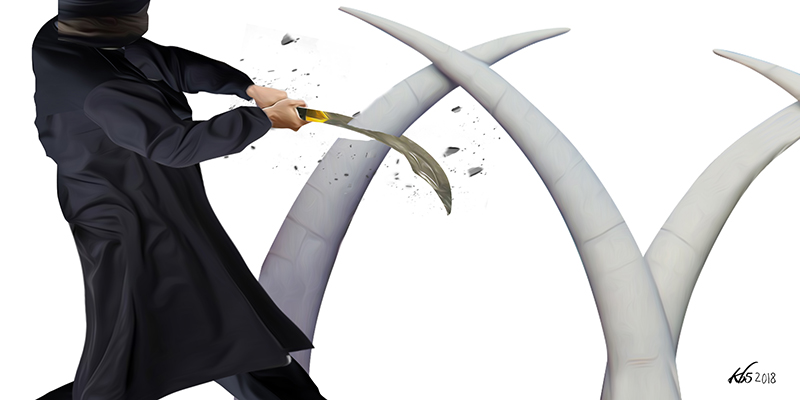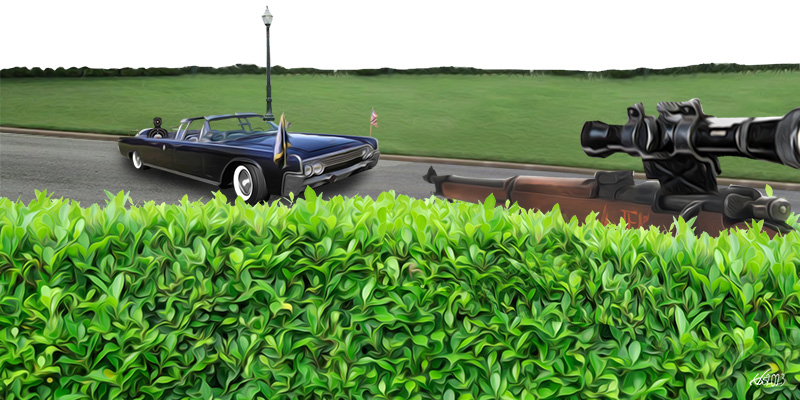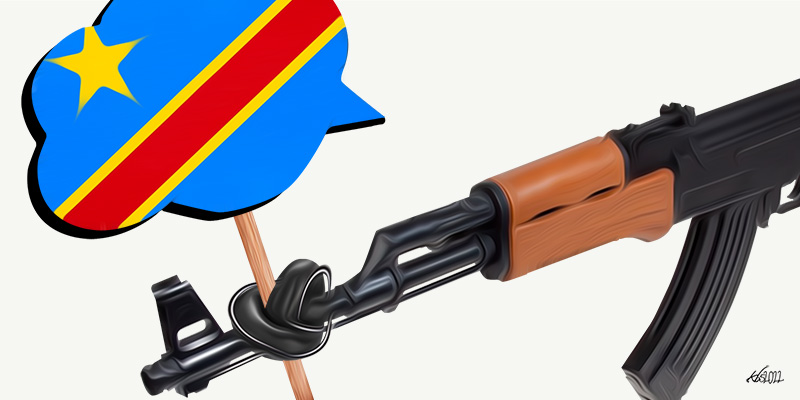The Embassy bombing of August 1998 and the twinned attack on a Kikambala tourist hotel and Israeli charter flight in 2002 led to the designation of the coast of East Africa as a primary theatre in the war on terror. Lamu featured prominently in the events that followed the emergence of homegrown terrorists. The new state of affairs was as unexpected as it was counterintuitive. For those who know the archipelago and its people, a remote and peaceful society like Lamu became associated with radical Islam defies the imagination. How this came about is a long story.
Religion and revivalism in the Lamu Archipelago
For people living in a place like Lamu scanning the horizon becomes a habit. For over two millennia, the triangular sails that with clockwork regularity appear in the distance near the end of the kaskasi winds brought new influences and exotic visitors who settled and became part of the Swahili coast’s hybrid mélange. Swahili language and culture evolved out of the long-term dynamic of cosmopolitan interaction interrupted by the occasional system-modifying disruption.
Islam, a source of stability that provided the template for the numerically small Swahili communities dealing with the vagaries of the outside world, took centuries to take root and flourish. During the eighth century C.E., political conflicts associated with the Sunni-Shia schism propelled small groups of Muslim refugees to the coast of east Africa. Islam spread slowly during the following millennium, integrating along the way influences from the hinterland like the kuzungusha ng’ombe and sorio purification rituals that the scholar Gunther Schlee identifies as originating with the proto-Rendille/Somali cultural complex.
The integration of such local practices congruent with Biblical and Quranic traditions apparently synched with the Swahili coast’s legacy of orthodox Islamic scholarship. According to a 16th century report credited to the Qadhi of Mecca, Lamu’s ulama religious council could hold its own in theological discussions with anyone. Lamu prospered as the archipelago’s main harbor, but remained under the control of Pate, which for centuries was the most powerful city-state between Mogadishu and Kilwa.
Pate went into decline after an internal war of succession broke out following the death of Fumo Omari, Pate’s Sultan in 1807. The long poem Al Inkishafi, the most powerful exemplar of classical Swahili poetry, contrasts images of the once powerful Sultanate’s former opulence with Pate’s ruinous state several decades later to illustrate the transient nature of the material world.
According to a 16th century report credited to the Qadhi of Mecca, Lamu’s ulama religious council could hold its own in theological discussions with anyone. Lamu prospered as the archipelago’s main harbor, but remained under the control of Pate, which for centuries was the most powerful city-state between Mogadishu and Kilwa.
The nineteenth century was a period of political turbulence across the Muslim world that prompted a rethink of Islam in Cairo, Istanbul, Mecca, and other centres of Islamic scholarship. Developments opened the door for the pan-Islamic political ideologies of religious rationalists. Reformers like Mohammed Abdul and Jamal Din Al Afghani advocated for Islamic education based on open inquiry and the search for knowledge over slavish commitment to medieval interpretations of Islam. In other areas, where Sufi traditions of experienced based religious knowledge were strong, reform focused on the personal internalization of Islamic values. One scholar writing about the Hadhramaut, a strong source of Islamic influence on the coast of East Africa, described the focus of religious renewal as “a shift from doctrine to praxis – i.e. as an attempt to bring to others the ‘tools’ for proper, good life, for ‘inner’ ability to separate right from wrong.”
The Ba’Alawiyya is Sufi tariqa established by descendants of the Prophet over a thousand years ago in the Hadhramaut. It became known later for championing the expansion of religious education while retaining its emphasis on Sharifite lineage. The Hadhrami diaspora that accelerated during the 1700s spread Ba’Alawiyya influence across the Indian Ocean from Java to East Africa. Several generations of Hadhrami scholars based in the Comoros and Zanzibar had through their scholarship and personal example promoted the quest for personal purity through the study of Islam’s original Quranic sources and traditions. This saw ulama religious councils in Zanzibar and the Comoros displace the influence of those of Lamu and Mombasa as the region’s ranking centres of religious knowledge.
The arrival of the charismatic Jamil al Layl Sharif, Habib Saleh from the Comoro Islands subsequently sparked the revival of Lamu as a centre of Islamic knowledge.
Salih bin Alawi, or Habib Saleh as he came to be known, was born in 1853 on the island of Grande Comoro. At the age of 18, the young Sharif followed his uncle Abdalla bin Alawi to Lamu to study with its Islamic scholars. After a sojourn in the Comoros he returned to Lamu, declaring that Lamu was the only place where he felt spiritually at home.
The arrival of the charismatic Jamil al Layl Sharif, Habib Saleh from the Comoro Islands subsequently sparked the revival of Lamu as a centre of Islamic knowledge.
During the last decade of the nineteenth century Habib Saleh acted on his belief that religious education should be available to everyone. The town’s stratified social order was already being challenged by the growing number of Hadhrami immigrants, Bajuni settlers from the archipelago’s outer islands, and freed slaves who settled in the area now known as Langoni. Habib Saleh built the original Ryadha mosque on a sandy hill above the expanding area of new settlement and went on to establish a mosque college modeled on the ribats established in the Hadhramaut by the previous generation of Alawi scholars. Ryadha offered religious instruction to all at a time when religious knowledge was still central to the power relations in Swahili settlements.
The Ba’Alawiyya taught that a religious leader should seek out obscurity in place of popular recognition, avoid material manifestations of wealth and power, and that they should keep a low public profile while continuing to offer advice to the community in religious matters. Habib Saleh personified these qualities. He also established a new Maulidi, the religious ceremony celebrating the birth of the Prophet, that featured litanies composed by one of his mentors, Al Habshi, recited to the accompaniment of the twari, a percussion instrument similar to the tambourine.
Habib Saleh’s educational pluralism put him into conflict with Lamu’s power establishment based in the old stone town, who tried to curb his activities. When this failed agents of the old order attempted to sabotage his growing influence by starting a fire in the Ryadha area of Langoni. According to the folklore, Habib appealed to his mentor in the Hadhramaut, Al Habshi, who intervened by using his mystical powers to miraculously extinguish the fire from afar.
These events coincided with the turbulent events accompanying the establishment of British imperialism in East Africa. As the archipelago’s pivotal role on the Swahili coast began to ebb, Kiwa Ndeo, the ‘Proud Isle’ as Lamu was known in Swahili verse, emerged as the center of a new Islamic movement that was to gradually spread beyond its coastal base. The town’s two religious streams coalesced after the success of Habib Saleh’s religious education revolution. His sons and grandsons proceeded to extend Lamu’s religious influence across the coast and into the interior of East Africa after the Saint’s death in 1938.
When I took up residence in Lamu in 1974, the Ryadha Mosque College buzzed with activity and housed students from as far away as Zaire, Tanzania, and the Comoro Islands. Lamu’s annual Mauled festival attracted Muslims from diverse backgrounds, including delegations from southern Arabia and Sudan, becoming one of East Africa’s major cultural events in the process. Wealthy Arab and Asian businessmen from Nairobi and beyond used the occasion to donate funds to the academy.
The festival had at some point expanded to include traditional Swahili dances that were performed in the large open area in front of the mosque. Elders from Pate and Ndau performed the slow moving Goma parade in immaculate white kanzu while the youth fought mock battles in the kirumbizi stick-fighting dance to the rapid cadence of the high-pitched zumari. After the conclusion of the Ishaa evening prayers, Miji Kenda gyrated to the rhythm of their ndurenge and mwanzele, the Pokomo did their mwaribe, and the wagema, the specialists in climbing the tall coconut palms to harvest the nuts and tap its sweet sap, performed their distinctive uta dance.
Lamu’s annual Mauled festival attracted Muslims from diverse backgrounds, including delegations from southern Arabia and Sudan, becoming one of East Africa’s major cultural events in the process. Wealthy Arab and Asian businessmen from Nairobi and beyond used the occasion to donate funds to the academy.
Not everyone accepted this exemplar of the Swahili coast’s tolerant and cosmopolitan Islamic culture. A small minority of Wahhabi influenced reformers objected to the use of the twari during the recitation of the Maulidi in Lamu mosques and the non-Islamic performances during the festival. Lamu religious leaders dismissed the complaints by stating that the Maulidi celebrated Habib Saleh’s tradition of inclusion, and that it attract new converts while maintaining positive relations with their non-Muslim neighbors.
Like the annual arrival of the dhows, the Maulidi’s importance for Lamu’s economic cycle had grown as the latter declined, in part due to the arbitrary imposition of customs duty and harassment by government officials. The rest of the year, Lamu’s economy largely depended on the traditional maritime activities and farming. The once vibrant mainland agriculture, however, was suffering due to poor security. Mainland Bajuni, displaced by Shifta bandit attacks in the 1960s, tried to resettle in mainland areas like Magogoni but found the going rough. A friend of mine gave up his farm there after being raised in the air by an elephant and dashed to the ground in front of his terrified children.
The Maulidi gained additional traction during this period as an advertisement for Lamu’s tourism, attracting a growing stream of Western visitors and high profile celebrities. On different occasions I saw the likes of Robert Redford, Omar Sharif, and Mick Jagger walking down the waterfront unrecognized and undisturbed. The hospitality industry became an essential growth sector that compensated for the decline of other livelihoods while revitalizing the production of artisanal crafts and the town’s famous woodcarving tradition. The building boom in Arabia led to a spike in demand for mangrove poles, reviving the international dhow trade. Remittances and returnees from the Gulf and Saudia Arabia provided a boost. After eight decades of economic stagnation, the archipelago’s economy began to sparkle again.
The Maulidi gained additional traction during this period as an advertisement for Lamu’s tourism, attracting a growing stream of Western visitors and high profile celebrities. On different occasions I saw the likes of Robert Redford, Omar Sharif, and Mick Jagger walking down the waterfront unrecognized and undisturbed.
These were simpler times, although much was changing underneath the surface. The tensions fueled by religious dogma and historical divisions elsewhere in the Islamic world were a non-factor except for the running debate over the distinctive Maulidi celebration spearheaded by Kenya’s chief Kadhi, Abdalla Farsi, and other Mombasa-based reformers. This debate was of little import in Lamu. The only dispute of significance was the internal rift between the Ryadha Sharifs that came into the open during the early 1970s when two of Habib Saleh’s grandsons started an alternative madrassa at Sofaa, a new mosque modeled on Ryadha and financed by a patron from the old Mkomani elite.
The contest between the traditionalists and modernisers remained couched in battles over local issues like the debate over the introduction of the Al Habshi version of the Maulidi celebration in place of the more generic Barzanji recitation, and its validation of the sharifs’ elevated spiritual station. It was difficult to see divisions like the longstanding Sunni-Shia conflict arising among the local believers in these settings. But events conspired to make this happen after a small freighter dropped anchor in the Lamu roadstead on an otherwise unremarkable June day in 1985.
Shi’a versus Bidha’a on the Coast of Kenya
The 1979 Iranian revolution upset the Islamic world’s political and religious status quo. The unanticipated strength of the events set in motion by Ayatollah Khomeini overturned both conventional and leftist concepts of the ‘grand march of modernization in the West, reviving religion as a driver of socio-political change for the first time since the Western Enlightenment.
One of the West’s most prominent academic authorities on Islam, Maxime Rodinson, had built a reputation by stressing that historically it was extremely difficult to find religious sources for Muslim responses to their situation: explanations should be sought in the “the social, cultural and ideological context of the age in which they operated than by their Muslim origin”. The country’s relative prosperity made developments in Iran all the more surprising for upending such theories. Analysts and policy makers were unprepared to assess the implications of what the Lebanese–born scholar, Fuad Ajami, termed “The Impossible Revolution”.
Internal Iranian participants in the upheaval also confused the broad spectrum of anti-government support that united under Khomeini, with the revolution’s Shia religious agenda. The centre did not hold. The Marxist Khalq Party was decimated. The interim Prime Minister, Mehdi Barzagan, didn’t last long. Khomeini banished any hope of accommodation by backing the students who took control of the US Embassy.
The broad spectrum of leftist groups and moderate middle class supporters who joined up with the religious opposition during the uprising could only rue their mistake. Like the many experts caught out by the events, they were left to contemplate Khomeini’s observation that “the Islamic revolution is not about the price of Persian limes.”
It was one of the seminal events of the Twentieth Century. Ayatollah Khomeini ended up on the cover of Time in 1979. The Saudi’s and their Western allies responded by backing Saddam Hussein’s doomed invasion of the contested Iraq-Iran border zone. The mutually calamitous military intervention morphed into a wider soft war to win the hearts and minds of the world’s Muslims, it was only a matter of time before the agents of this proxy battle showed up on Kenyan shores.
Egypt was the first modern Islamic voice to influence Muslims south of the Sahara, and religion did not figure prominently in the message. Gamal Abdel Nassir used the Voice of Egypt to break the European control of the airwaves and focused on anti-imperialist themes reinforcing African aspirations for independence. Egyptian radio broadcasts of the 1960s eschewed the sectional interests of the region’s diverse Muslims and instead cultivated support for the non-aligned movement. But after Nassir’s death, economic power replaced ideology, and patronage links with Saudi Arabia took over as the primary conduit of external influence on the Islamic periphery.
The mutually calamitous military intervention morphed into a wider soft war to win the hearts and minds of the world’s Muslims, it was only a matter of time before the agents of this proxy battle showed up on Kenyan shores.
Most of their funds were transacted on the state level with a view towards cementing ties of economic cooperation while curbing Israeli influence. The rest went to support madrassa education and to train teachers. In Kenya, a new generation of scholars and Imams, many of whom were sponsored by the Saudis, were opposing superstitions like belief in the power of amulets, quasi-religious divination and magic, and other practices tolerated by the Sharifite establishment. But despite its decidedly non-Wahhabi orientation, Lamu’s Ryadha establishment also received Saudi support.
Although Saudi aid at that juncture highlighted secular principles, it was part of a longer-term strategy twinning cultivation of Wahhabi ideology with support for the Kingdom. The Iranian Revolution shook up this patrimonial status quo, and in Kenya, Iran’s new popularity complemented coastal Muslims’ antipathy for the ‘Arabs’.
During my early days on the coast I was frequently confused by the contradictions conveyed by the word “Arab.” As far as I could see, although only religious scholars and relatively recent Hadhrami immigrants actually spoke Arabic, many coastal Muslims aspired to a degree of Arab-ness through dress and language, while real and imputed connections to Arab lineages conferred prestige. Bajuni oral tradition, for example, states that these indigenous African Swahili originated in Mecca. I was naturally perplexed when a Bajuni friend remarked, “Arabs are the worst people in the world.
Other coastals who came from high status ‘Arab’ families expressed a similar attitude, claiming that the Arabs of Arabia are primitive and vain. Jokes about the Saudis in particular were common, especially among coastals returning from the Kingdom who found life in Arabia difficult and suffocating. The large number of coastals who migrated there in search of work found themselves treated as low status migrant workers. Merchants with important business connections sometimes echoed the negative attitudes prevalent among the Swahili and near universal among the Somali. “The Saudis are very nice when you meet them here,” one Mombasa tycoon told me, “but if you deal with them in Arabia they are the worst of savages.”
A convoluted mix of Arab-philia and Swahili cultural autonomy reflected the conservatism of many local scholars and Imams, who tended to steer a neutral line between the influence of internal reformers and external religious patrons. What they shared in common was their reluctance to address the political marginalization of Kenya’s Muslims.
This began to change after the 1979 revolution. Iran became a symbol of the fight back against Westernisation. Their efforts to promote Islamic moral renewal highlighted local grievances over historical injustices and other issues that were never championed by the Arabs and their political clients. For the first time since the late nineteenth century, coastal Muslims could look to a role model in Ayatollah Khomeini who combined religious integrity with political liberation. Pictures of the Ayatollah joined the pantheon of cultural heroes on the coast, sometimes sharing a wall with Bob Marley and Bollywood film stars.
A convoluted mix of Arab-philia and Swahili cultural autonomy reflected the conservatism of many local scholars and Imams, who tended to steer a neutral line between the influence of internal reformers and external religious patrons. What they shared in common was their reluctance to address the political marginalization of Kenya’s Muslims.
During the early 1980s the Iranians initiated efforts to exploit their religious capital by cultivating influence on the coast. They established an Islamic newspaper in Mombasa that discussed social problems and offered religious commentary. The Iranian Embassy sponsored delegations of local notables and sheikhs to visit Iran. Most returned speaking of Iran in glowing terms; the Saudis responded by flying many of the same individuals to Mecca and Medina. The narrative emerging out of these junkets confirm the reports of seamen who reported how they were welcomed as Muslim brothers in Iranian ports like Bandar Abbas but were treated poorly on the other side of the Persian Gulf—where Christian expatriates were received with open arms.
The Iranians’ efforts gradually brought some religious leaders under their influence, including Abdullahi Nassir, former leader of the pro-secession Coast Peoples Party, who was commissioned to deliver a series of lectures across the coast. In Lamu, the internal conflict between the Ryadha and Sofaa sharifs provided another entry point.
In 1983 Sofaa had recruited the assistance of the long-serving Mombasa politician, Sharif Nassir. The two factions typically supported different candidates in local elections, and this presented Nassir with an opportunity to leverage his support among the large Lamu community in Mombasa. The coast’s pre-eminent politician held a harambee at the Sofaa Mosque to raise funds to build a new madrassa and dormitory. Shortly afterwards the Iranians offered their assistance for the same project.
When I visited the mosque in May of 1984 I found a new over-sized version of the original Sofaa and a new educational complex erected on the plot behind it. A block of classes funded by Nassir’s harambee remained incomplete, like a testament to the old order. I was told that Mzee Mwenye, the head of the mosque and its Imam, Mwenye Omari, had embraced the Ithna Asheri school of Shi’ism. When I spoke to them, they said they were grateful to their new Iranian friends for improving the facilities but otherwise nothing significant had changed.
The mosques beautiful new calligraphy with its references to the Shia martyrs Hussein, Hassan, and the Prophet’s daughter, Fatima, indicated otherwise. The conduct of prayers and most everything else was the same, although my father-in-law confirmed that the pro-Shia management had began using the Shia version of the call to prayers before the complaints of the neighborhood’s residents saw it discontinued.
East African Muslims are a multicultural community where until recently sectarian differences rarely served as a source of friction. Bohra, Ismaili, Ithna Asheri, and other Asian Shia Muslims lived among the Sunni majority in coastal towns and cities and even married Sunni wives occasionally. This explains why Sofaa’s Shia affiliation was, for most people in Lamu, more about the ongoing Ryadha-Sofaa feud than a break with Lamu’s Islamic tradition. My father-in-law and many other former regulars continued to pray at Sofaa despite the changes.
The conflict nevertheless began to ramp up over the following months as the two factions engaged in various battles for influence, beginning with the recruitment of children to attend their respective madrassa. My wife was perplexed when competing representatives of Sofaa and Ryadha had come to the house advising her to enroll our children in their respective Quran schools. They warned of the negatives that would result if they remained in their present chuo, which was not affiliated to either faction.
The Sofaa faction won a legal victory when they went to court to prevent the eviction of a popular female maalim based in a vacated Shi’a mosque that had not been used for decades. This was followed by a battle over selection of a new mosque for hosting Friday prayers. The traditional Mskiti wa Jumaa in Mkomani could no longer host the town’s growing numbers, forcing late arrivals to pray on the sidewalks and alleyways outside the mosque. When Sofaa lost their bid to be selected as the second Jumaa mosque, partisans chained the doors of the eight hundred year-old Pwani Mosque – identified with Lamu’s pre-Ba’Alawiyya ulama – that had been chosen instead. The District Commissioner, however, intervened on behalf of the anti-Sofaa clerics.
Lamu people discussed these developments in their usual jocular fashion, referring to the parties as Watu wa Shi’a and Watu wa Bidha’a, the latter being a reference to the criticism of the Maulidi who claimed it was the kind of religious innovation forbidden in the Quran. Most everyone I knew viewed the events as a family affair that had burst into the open with comic effect. No one took down their pictures of the Ayatollah, even though their take on the revolution had soured during the interim.
Prior to these developments, in 1982, a fire consumed a large area of Langoni. It started after a quarrel between a brother and sister ended with the brother setting the house on fire before dawn. The prevailing kuzi winds spread the flames across Langoni’s canopy of palm-thatched roofs, incinerating hundreds of the densely packed mud and wood houses and spreading to the coral rag stone structures lining the Msitu wa Mui, Lamu’s main street which the government had ineffectually renamed Kenyatta Avenue. When the fire moved uphill towards Ryadha, the mosque’s senior Imam, Sayyid Ali Badawy, came out of the mosque waving Habib Saleh’s flag. The wind died and the fire expired without causing further harm. I was upcountry at the time. When I returned to Kiwa Ndeo a week later, a posse of eyewitnesses confirmed this sequence of events.
International and Kenyan donors committed funds for rebuilding a new mabati (corrugated iron)-roofed Langoni, but the promised reconstruction of the homes dragged out. A year later many households were still camping in makeshift structures built on the ruined plots; after two years some victims on the list were still waiting for compensation. Most of the damage occurred on the Sofaa side of town, which ostensibly led to the mission of the mysterious freighter that arrived almost three years later.
When the fire moved uphill towards Ryadha, the mosque’s senior Imam, Sayyid Ali Badawy, came out of the mosque waving Habib Saleh’s flag. The wind died and the fire expired without causing further harm. I was upcountry at the time. When I returned to Kiwa Ndeo a week later, a posse of eyewitnesses confirmed this sequence of events.
The ship carried clothing for the victims of the Lamu fire donated by the Shi’a community in Kuwait. It spent a long time anchored off Manda Island while the Sofaa sharifs negotiated the cargo’s release. Several months later the goods were cleared, but because they were officially listed as charitable donations for the community at large, the Provincial Administration claimed that other religious actors should be allocated equal shares. As it turned out, the shipment contained many items of high quality, and distribution proceeded on a prejudicial basis. Some recipients reported that they found dollars and riyals in the pockets of donated kanzu; a fisherman showed me a Seiko watch he found in the ‘Kuwaiti’ gown he received.
For a while “umepata Kuwaiti gani?” became the first question people asked after the usual greeting. Many of the genuine victims received nothing. My brother-in-law, who lost more than most when his shop and home burned, missed out. The generosity of the foreign benefactors ended up generating more controversy than relief.
The issue was settled when, during Friday prayers a group of youth broke into the storeroom where the Kuwaiti cargo was kept. They made off with the remaining chests and footlockers. They broke them open on the waterfront, dumped out the contents, and ran off after taking the pick of the loot—which was mainly shoes. The public scrambled for what was left, all evidence of the heist vanishing before the faithful in the mosque uttered the final “Assalamu alaykum wa barakatuh” ending the prayers. The news spread fast.
“These guys committed a major sin!” one my neighbors declared.
“What’s so wrong about liberating what was supposed to be gifts for the poor?” I asked.
“Nothing,” he said, clarifying that “it was bad because most of the best things went to the slackers who don’t attend Juma’a prayers.”
That was not the end of it. In the scramble for the footwear most of the pairs were separated. Several times a day someone would call hodi hodi from downstairs, walk up the stairs, and after the usual salutations produce a bag filled with unmatched shoes.
“Uko na ndugu ya hiki?” invariable followed, as they placed a single Italian loafer or a fashionable woman’s stiletto on the mat.
The exercise continued for several weeks. Although I surmised many of the shoes were never united with their ‘brothers’, it helped restore a degree of normality to community after the antagonistic Shi’a versus Bidha’a interlude. Twice, women who were not on good terms with my spouse clunk-clunked up the stairs and politely made their enquiries, and I observed how the process resulted in the resumption of normal relations.
Things did not end well for the warring sheikhs. The infighting continued, and the resulting decline in status coincided with the rise of a new generation of more activist reformers with comparatively shallow educational and spiritual qualifications than their predecessors.
Assessing The Aftermath: The Kingdom Strikes Back
At the time I viewed this incident as a victory for local religious sensibilities over the forces of patronage and imported religious models. But the influence of the Ayatollahs’ revolution had opened the way for political Islam to take root in local conditions. No one anticipated the directionality of events over the next two decades.
The Iranian gambit ended up producing the opposite effect in respect to their political interests, with correspondingly negative implications for the Muslims of this region. Infatuation with the Islamic revolution declined as the Iranian government began to show its authoritarian nature, and the Saudis went on the offensive. Iran’s pan-Islamic activism in turn prompted Saudi Arabia to adopt a more aggressive role across the Islamic world. Over the course of the 1980s the Kingdom spent over $4 billion per year to spread the Wahhabi creed abroad. Private sources in the kingdom interpreted the Mujahedeen victory in Afghanistan as divine approval for their version of jihad, and extended their funding for radical Wahhabi movements across to virtually the Islamic world.
The gradual spread of Wahhabi influence provided cover for the proponents of the more extreme Salafi movement before the Embassy bombings of 1998 accelerated the convergence of the global Islamist narratives across the Horn of Africa region. This coincided with the spread of social media and internet-based transmission of Islamist ideologies, which gained ground at the expense of the transmission of formal Islamic knowledge through recognized schools of jurisprudence and the human exemplars of Sufi teachings.
We all know what came next.
The irony is that Lamu, home to the Islamic tradition that is most resistant to religious extremism in the region, has suffered disproportionately from the international cast of Al Qaida sleeper cells and Al Shabaab insurgents based across the Somalia border.








